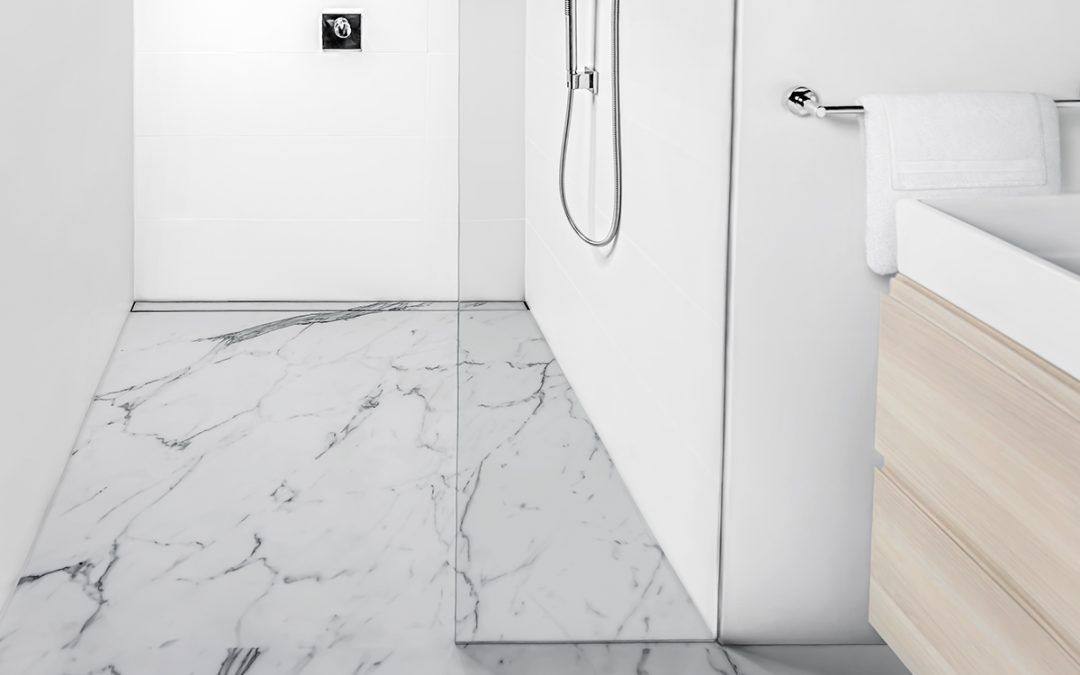When it comes to installing a linear shower drain, the most important thing to consider is the placement of the shower. The linear shower drain placement has to be on the shower floor with a slope towards the drain end. This way, the water flows through the slop for proper drainage.
There are several locations in a shower where you can install your linear shower drain. Such as against the wall, wall-to-wall, triple-sided installation, L-shape, threshold installation, drain in center, and one-sided installation.
Choosing the perfect location for your shower can help you find the To learn more about that, you can keep reading as we are about to explore these placements in detail below.
Understanding the importance of proper shower drain placement
Where you install the shower drain plays a huge role in keeping your shower free of water or any other junk in the shower. Whether it’s hair or debris or soap residue, it doesn’t matter. Without the proper shower placement, there will be no water flow, so you end up with a dirty shower.
You need to place your shower drain in such a place where all the water from the shower will end up going. It can be in the center or on the sides, depending on how your shower was built. But always remember that the shower can’t be flat, and it has to have a slope.
The critical thing to notice here is that you have to allow the water to flow down the drain. And that is only possible if the shower drain is placed in the lowest part of your shower.
Check out this video below to get a better understanding of how to shower drains actually work if you are a newbie in all this.
🤔 Linear drains for tile showers explained👍
Now, one thing to remember is that the drain doesn’t need to be at the center of the shower all the time. As long as you are placing it on the lowest point of the shower, it will work for sure, and you won’t have any issues.
Benefits of having a well-placed drain in a shower
The right drain placement in showers comes with a lot of benefits. These are pretty obvious benefits, so there is no way you will ever overlook them. Let’s get through them one by one.
- A well-placed shower drain will drain the excess water and waste from your shower quickly.
- It keeps the shower clean for a longer time and requires less cleaning in the shower.
- Perfect shower drain placement can also add to the aesthetics of the shower.
- With the ideal position for shower drain, you can have a safer shower, as your chances of slipping on the water will be low.
- Lastly, a proper shower drain placement keeps all the water inside the shower without seeping through the shower entry.
As you can tell, choosing the right shower drain location can help you avoid many shower drain problems. It’s much more convenient and helpful for any homeowner out there.
Linear drain placement: The best place to install a linear shower drain
When it comes to the position of installing linear shower drain, there are several optimal locations available for you. Each of these locations has its unique set of purposes which make them suitable for different showers.
Here, we will be going through these locations and how they can impact the shower. We also leave some recommendations for linear shower drains based on the location to make things much easier for you. Let’s get started.
Option 1: Wall-to-wall installation
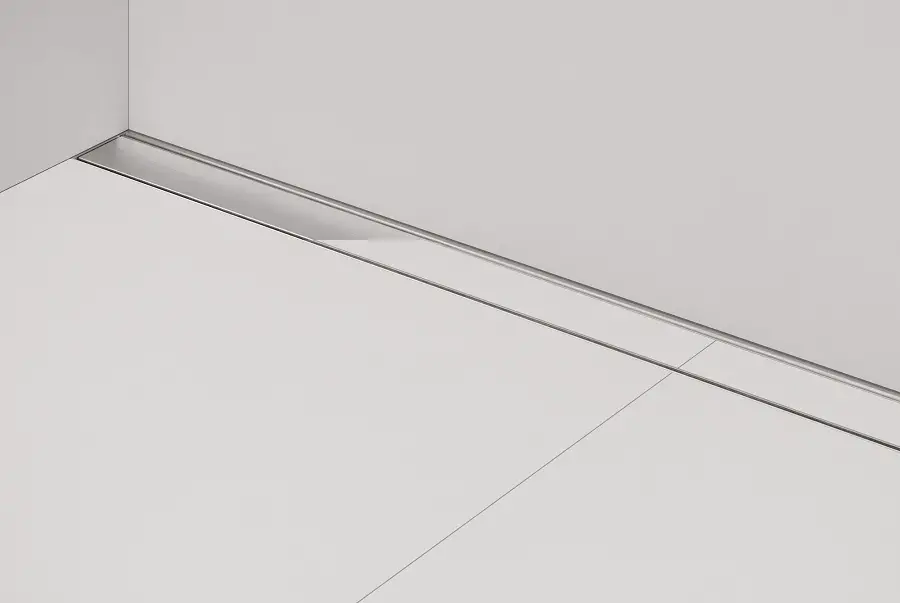
In the wall-to-wall installation of a linear drain, the drain will cover the whole length of one side of the shower wall. Here, you must ensure the floor is pitched exactly in the direction of the drain. You usually have to place it right on the shower wall as if it’s flushed against it.
Benefits of wall-to-wall installation:
- Provides a seamless modern appearance
- Features excellent waterproofing capabilities
- Doesn’t require any unnecessary curbs or walls
- No need to include additional tiles to complete the installation
- Reduces the chances of accidents.
- Water can flow only one way to keep a part of the shower dry.
Recommendations:
When it comes to getting a linear drain for wall-to-wall installation in your shower, Amazon has some amazing options. Their Dera-line and Garda-line are the perfect options for the wall-to-wall placement of a linear drain.
You get these in 9 standard sizes, and there is also an option to get them in custom sizes if you want. So, you can get these drains perfectly suited for your shower with wall-to-wall installation.
Option 2: Against-the-wall installation
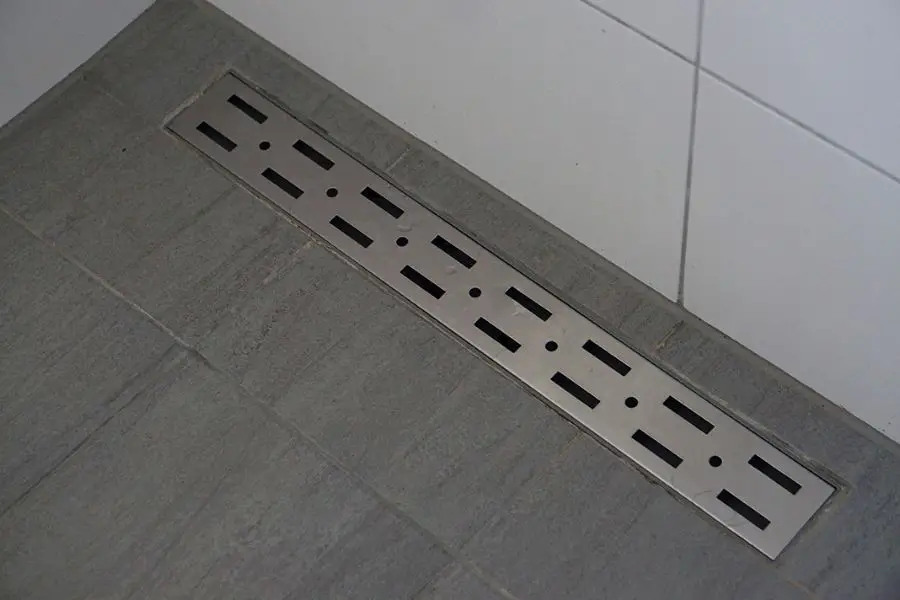
It’s pretty much similar to the wall-to-wall installation, where you install the linear drain adjacent to one side of the shower wall. But here, the two sides of the drain don’t need to be connected to a wall. One side can still have an open end.
Benefits of against-the-wall installation:
- It eliminates the necessity of tiling behind the drain
- Water splashes will go directly into the channel
- These placements are perfect for modern waterproofing
- Installation is much easier with this kind of linear placement
- Looks very stylish and sophisticated
Recommendations:
For against-the-wall installation, you can always rely on the fixed flange series from Infinity Drain. These drains have a specific design to flush them against a shower wall.
They provide you with liquid or fabric waterproofing which works great when you are installing your drain against the wall.
Option 3: Off-the-wall installation
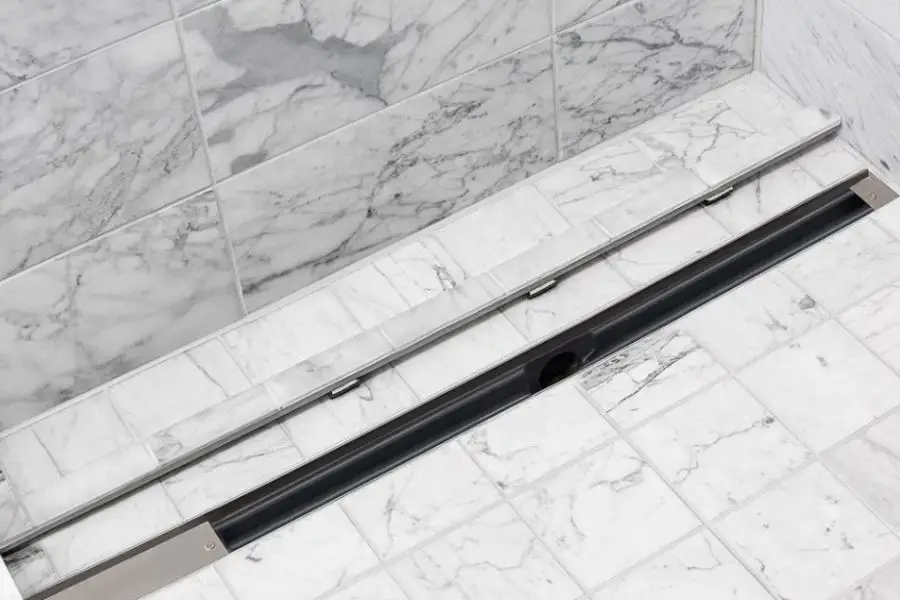
As you can tell from the name, off-the-wall installation is where you will install the linear drain away from the wall. Unlike the other two placements, the drain will not touch the shower wall. Also, there will be a gap of around 2 inches between the drain and the wall in most showers.
Benefits of off-the-wall installation:
- It can be great for showcasing the tile aesthetics
- Works great when you plan for a tub-to-shower conversion
- Doesn’t require too much plumbing work for relocation
- There is room for protecting the shower wall with proper drainage
- Great for preventing any mold growth or bacteria formation
Recommendations:
With off-the-wall installation in your shower, Dera-Line and Garda-line might once again be an optimal choices. Since they come in custom sizes, you can cater to them based on your needs. For traditional waterproofing, pick Dera-line, and for liquid waterproofing, go with Garda-line.
Option 4: Barrier-free installation
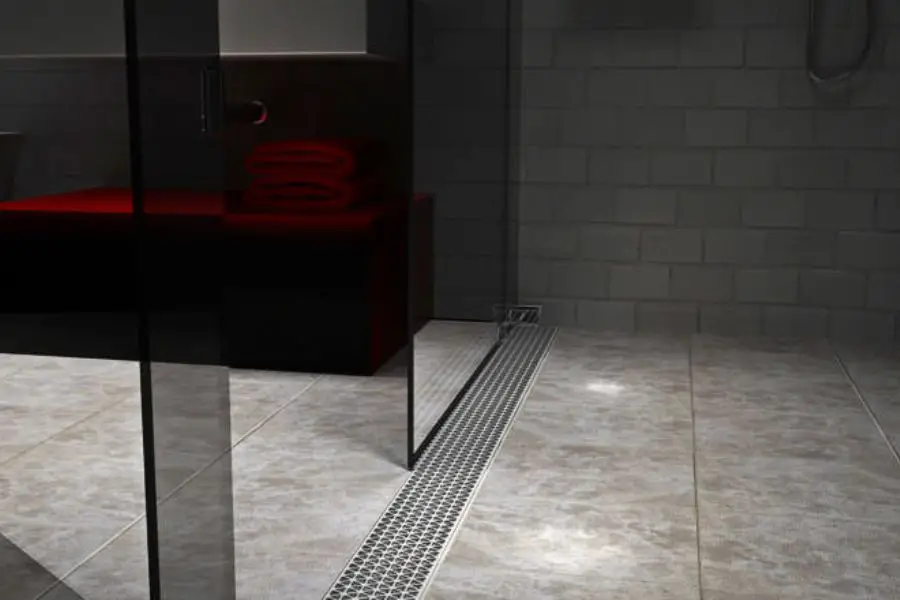
Barrier-free installation is the perfect solution whenever the floor surface is flat between your shower and the remainder of the bathroom. It’s also known as a curbless installation of the shower drain. Usually, this kind of drain is placed between the dry and wet areas of the shower.
Benefits of barrier-free installation:
- Creates a seamless modern look in the shower
- Easy to access the shower for people with mobility issues
- Allows for consistent tiled flooring in the bathroom
- Doesn’t require any adjustments to the tiles in the shower
- Keeps the dry are away from water even without a barrier
Recommendations:
We have two recommendations for a barrier-free installation of a linear shower drain. One is the Garda-line from showergrateshop, which will be your best pick.
And from Infinity Drain, you can try out the FF and FT series along with the ST65. Any of these should work effectively as barrier-free linear drain installation in your shower.
Option 5: L-shape side-by-side installation
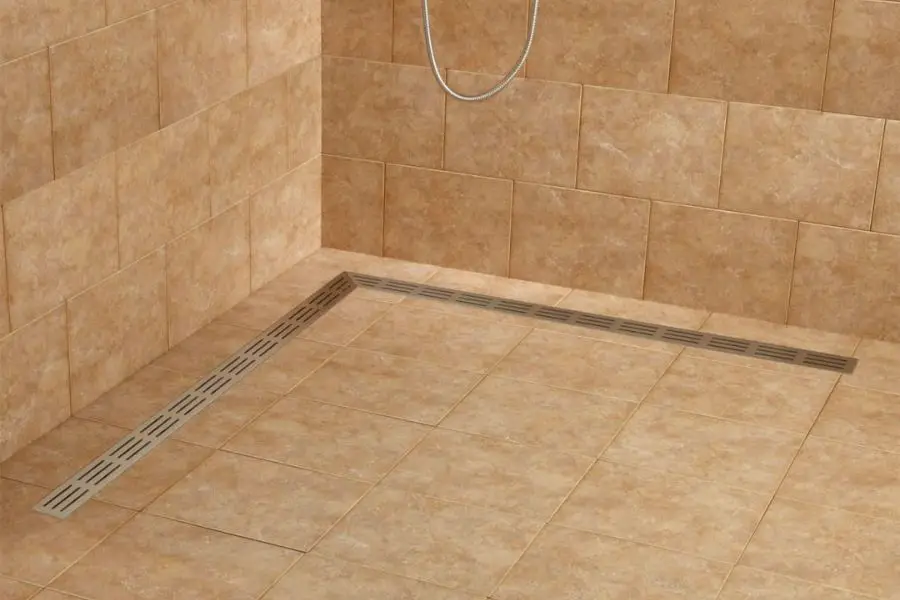
In truth, an L-shaped installation is quite similar to a wall-to-wall installation, except these cover two sides. With this type of installation, you will be covering two connected shower walls, and the linear drain will cover the two walls for the most part.
Benefits of the L-shaped side-by-side installation:
- They can drain more water than one-sided linear drains.
- It’s more appealing and fulfilling to see an L-shaped linear drain.
- Drainage capability is excellent on these installations.
- Provides less to no room for water leakage
- Great separation of dry and wet areas
Recommendations:
Mostly, you can go with any linear drain suitable for wall-to-wall installation with a customized size and get two of them.
But if you want the best option, we suggest checking out the S-AG series from Infinity Drain. They are sizeable according to your needs and suit the L-shape.
Option 6: Threshold Installation in shower entrance
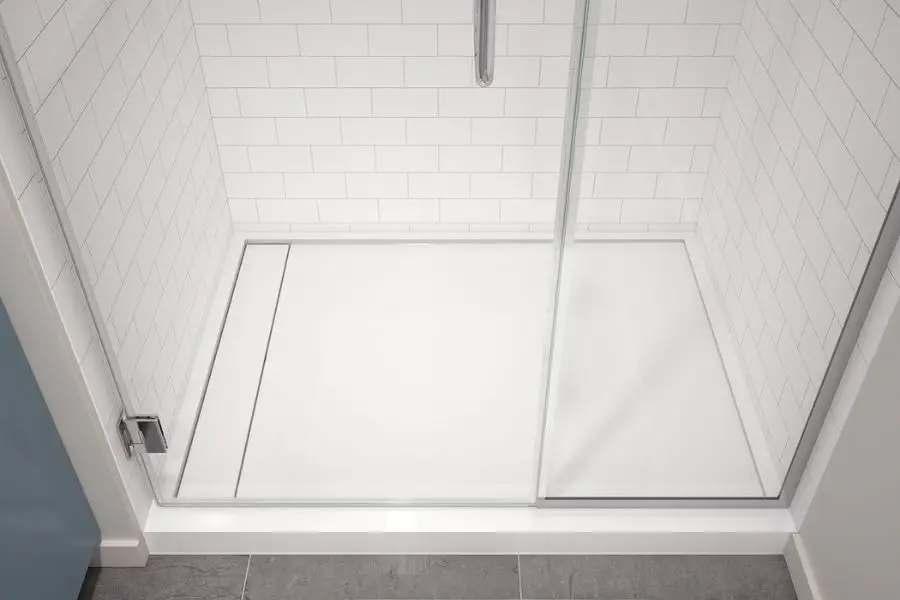
Other than wall-to-wall installation, threshold installation is a common position for installing linear shower drains. It’s simply installing the drain right at the shower’s threshold or the shower’s door. The drain covers the whole area of the shower entrance to drain the water properly without wetting the dry area of the shower.
Benefits of threshold installation:
- Helps in keeping the water within the wet area
- These are great solutions for overflowing showers
- Works well for a smaller shower with no excess spaces
- Doesn’t require the use of tiles to complete the installation
- Drainage speed and quality are quite impressive on these
Recommendations:
There are plenty of linear shower drains out there that work great for threshold installation. But for the absolute best choice, you can get the Gerdi-line from showergrateshop or you can try out the S-AS 65 from Infinity Drain.
Option 7: Drain in-center installation
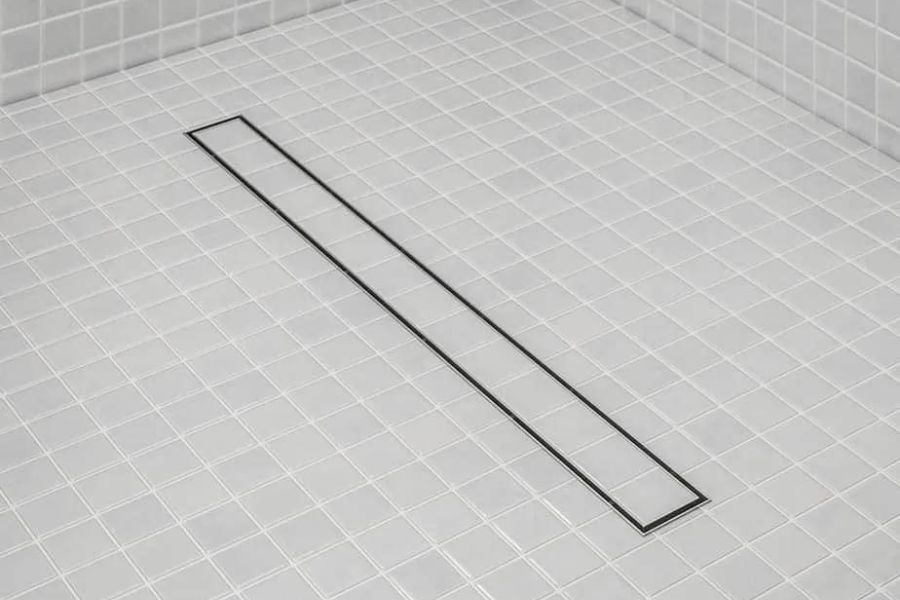
Linear drains are mostly about the aesthetics of a shower, and the best way to highlight the linear drain is to install it right in the center. If the shower is sloped towards the center or has a center drain, this placement will be perfect for your linear drain.
Benefits of Drain-in center placement:
- It creates a unique look in the shower
- Works well for draining from all sides of the shower
- Perfect as a replacement for a bathtub without requiring plumbing
- Water drains very quickly in such shower drains
- They are excellent for a smaller shower setup
Recommendations:
Center drain placement is becoming quite popular with linear shower drains for their unique appeal. With Infinity Drain, you can get the TD or TDB series for center linear drain placement. Besides that, the Gerdi-line and Dera-line from showergrateshop are also suitable choices.
Factors to consider when determining the position of a linear shower drain
Finding the perfect linear drain positioning is not as easy as you would think. Several factors go into figuring out the perfect position for a linear drain in your shower. We will take you through the considerations for shower drain placement with a linear shower drain. Here are the factors you should be considering –
The shower floor slope
The first and major factor that you have to consider while choosing the location of your linear shower drain is the slope. If the shower floor is pitched towards a particular side of the shower, then wall-to-wall can be a perfect placement for the shower.
On the other hand, The drain-in center location is perfect for a shower floor pitched towards the center, where it slopes from all four sides. And if the slope is a bit distant from the wall, then the off-the-wall installation is pretty good.
Lastly, when the slope of your shower is right on the shower entrance, you go with barrier-free or threshold placement. So, a lot of the placement depends on the slope of your shower floo
Shower style
Whether you have an open shower or a closed shower can also dictate the placement of your shower floor. For instance, if you have a door with a closed shower, wall-to-wall, against-the-wall, or off-wall placements can be great options.
But if you have a curb or curbless shower, you can try the threshold installation for it. They are also great for walk-in showers. With a tub-replacement shower setup, having a drain in the center placement is the perfect solution with quick drainage.
Size of the shower
Another thing to consider with the linear shower drain placement is how large your shower is.
With a larger shower, you will have a much more difficult time installing a wall-to-wall placement as you have to cover a whole side. So, there a center drain or off-the-wall drain will work great.
Threshold and barrier-free placements also work great for larger showers as the water will go toward the entrance.
In a smaller shower, it’s always better to have a wall-to-wall shower for a modern look. Center drain placement can also work pretty well in such showers.
Preferred design and looks
The kind of appearance you are planning to have in your shower will impact where you install the linear drain. With wall-to-wall or against-the-wall installation, you can expect a modern low-key appearance.
If you want to show off your tiles a bit more, then off-the-wall drain placement can be the right choice for you. On the other hand, the center drain placement gives you a unique appearance in the shower.
With threshold or barrier-free installation, you get an open-end shower look that makes the shower appear more spacious. They are also suitable for disabled people.
Common mistakes to avoid in shower drain positioning
When it comes to the proper placement of linear shower drains, you can make some common mistakes. Avoiding these mistakes is necessary to avoid issues with the shower in the future. So, let’s go ahead and check out what mistakes to look out for while placing your shower drain.
- Not planning through the whole installation process
- Focusing on aesthetics more than the build of the shower
- Choosing the wrong kind of shower drain for the wrong placement
- Trying to install the shower drain without any expert opinion
- Going with the wrong kind of waterproofing based on location
Important Questions About Linear Shower Drain Placement You Need to Know!
There are many questions regarding the shower drain positioning for linear drains. People often ask these questions and seem to be constantly confused about them. Check out the answers below and meet your curiosities.
What is the ideal size for a linear shower drain?
Typically, the ideal size for a linear shower drain is around 36”. Even though they start from 24”, the standard size for most of the linear shower drains goes from 30 to 36 inches.
Can I install a linear shower drain myself, or do I need a professional?
Getting a professional plumber to install the linear shower drain for you is very important. Because these shower drains are critical to install, you can easily mess up the installation. And even a minor flaw in the installation will cause many issues later.
Are linear shower drains more prone to clogging?
Yes, linear shower drains can have more issues with clogging. Even though they have excellent water flow and drainage, they can get clogged easily compared to usual drains. Since they are longer, more debris and hair can build up in the drains.
Can I retrofit a linear shower drain into an existing shower?
Yes, you can retrofit a linear shower drain in an already-existent shower. In fact, it’s very common to remodel a shower with linear drains as long as it meets the requirements of the shower. You can switch from a point drain, or you can also go from tub to shower conversion.
How do I choose the right linear shower drain for my shower design?
Choosing the right kind of linear shower drain is all about determining the location of the drain and knowing the type of shower you have. You must consider where the shower has its lowest end and place your shower drain based on that. Curb or curbless showers will also play a role here.
Are linear shower drains compatible with different types of flooring?
Yes, linear shower drains are compatible with almost all types of flooring. Whether it’s tiled, concrete, think flooring, or vinyl, it doesn’t matter. However, they go very well with tiled showers compared to any other flooring.
Can linear shower drains be used in barrier-free or accessible showers?
Yes, you can use linear shower drains in barrier-free showers. As long as the shower floor is pitched towards the entrance of the shower, a linear shower drain should work quite well. In fact, they are quite a popular choice for barrier-free showers these days.
What are the costs associated with linear shower drain installation?
Usually, the lowest cost to install a linear shower drain will be around $100 without considering the labor or reconstruction costs. When you consider the labor or reconstruction costs, it can go up to $400 to $600, sometimes even more. They can be very expensive, for sure.
Where is the best place to install a linear drain?
Typically, the two best places to install a linear shower drain are at the entrance of the shower or the opposite side wall. It will significantly depend on where the shower floor slope is. Depending on the slope you can find the best place to install a linear drain for your particular shower.
What Next?
Now, you know everything there is to know about linear shower drain placement. It’s time to act on your knowledge. If you plan to install a linear shower drain in your bathroom, get started with finding the slope.
From there, you can decide which shower drain placement will suit your need best. And if you are building your shower, you can create the slope based on your interests.
Overall, the placement of your linear drain has its pros and cons in every case. So, it comes down to your preferences and what you don’t want in your shower.

